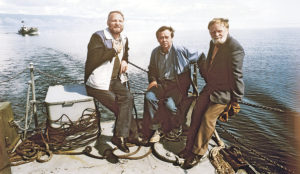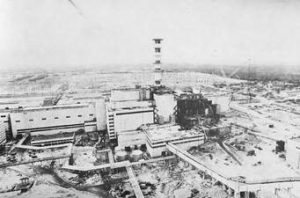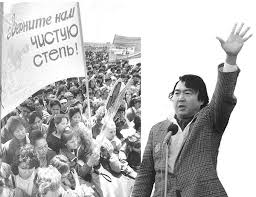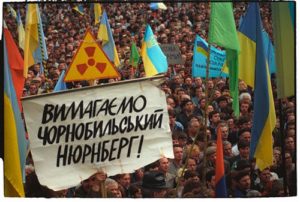Ecology and Nationalism in the Periphery Republics of the Late USSR (1987-1991)

Introduction
Ecology has been one of the most prominent spheres of authorized public criticism in the USSR from the end of the 1960s onwards. Many non-conformist intellectuals (writers as well as scientists) were allowed to publish critical texts to report violations of environmental laws, industrial accidents and ecological catastrophes, or even to call for mobilization of the intelligentsia and of the broader public to hinder or postpone industrial or construction projects. Protection of Lake Baikal from the damages caused by the construction of a paper pulp factory and the opposition to the Siberian river diversion projects were the most famous environmental causes in the 1960-1970s.

The beginning of the 1980s was a turning-point. By then, ecology was made a privileged sphere of the ideological propaganda and political discourse by the Department of Propaganda of the Central Committee of the CPSU (Отдел пропаганды и агитации ЦК КПСС), under Head of KGB Yuri Andropov’s pressure. In late 1982 and all throughout 1983, CPSU daily newspaper Pravda published a series of sharply critical articles of the ‘idealistic and contemplative’ position adopted with regard to nature and environmental questions by some publicists and writers. According to the party rulers, the writers’ idealism, if not ‘romanticism’ – for whom nature protection was a close synonym to heritage protection (наследие) -, should be replaced with a more rational approach and set out the shortcomings in the Soviet economic system. The press was invited to switch subjects and cease to impute the ecological crisis to a ‘lack of respect for our heritage’ or to the ‘barbarity of urban society’ (in the words of Siberian ruralist writer Valentin Rasputin /see photograph above), but to denounce the ‘very serious administrative flaws’ and the ‘untolerable negligence by the people in charge’. The press was invited to expose ‘balanced expression of views’ in feature articles which should give way to digests of readers’ letters or investigative articles denouncing specific cases of irresponsibility. The often barely concealed ‘anti-modern’ Weltanschauung expressed by a substantial group of the Soviet intelligentsia via environmental criticism was to be couterbalanced by a more ‘progressive’ (i.e. less ‘anti-progressive’ and ‘reactionary‘) approach, dictated from ‘above’: officials claimed their will to explore practical ways to ‘solve environmental problems’. This eventually drove to a series of orchestrated media campaigns in the Soviet official press in 1982-1984, generating noisy scandals with a particular insistance on public health consequences, ending generally in exemplary sackings of ‘irresponsible’ factory managers or ‘incompetent’ Heads of Departments in industrial ministries, and sometimes even to judicial procedures and spectacular (and mediatized) trials[1]…

Ecology : a ‘Surrogate’ for Nationalism ?
As a matter of fact, a few years before the actual start of Perestroika (1985), Soviet environmentalism was ways on its path to the dominance it would soon acquire in the public sphere at the time of glasnost and demokratizatsiya. Interestingly enough, environmental ‘romanticism’ with a strong nationalistic accent did not at all cease to exist, but on the contrary, seemed to spread in the periphery republics. Soon after Chernobyl nuclear plant accident (April 1986), environmental problems topped the list of the many causes that aroused public mobilization and critical expression towards the authorities. Natural catastrophes, public health scandals, air pollution, overweeningly gigantic industrial projects became a major stimulus for glasnost. In her fundamental work on Eco-Nationalism in the late USSR[2], Jane Dawson looks at the rise of the anti-nuclear power movement in post-Chernobyl Ukraine and in Lithuania. She acknowledges the ‘unexpected successes’ (in regard to the immediate past) of this movement in the late 1980s and ‘its substantial decline’ after the collapse of the Soviet Union in 1991, arguing that anti-nuclear activism, being one of the most dynamic social forces to emerge during these years, « was primarily a surrogate for an ever-present nationalism » and a means of demanding greater local self-determination under the Soviet system. Rather than representing strongly held environmental and anti-nuclear convictions, Dawson sees this activism as a political effort that reflected widely held anti-Soviet sentiments and a resentment against Moscow’s domination of the region — an effort that largely disappeared with the collapse of the USSR and the subsequent building of Post-Soviet independent states.

Examining Perestroika’s Eco-nationalisms in a broader historical and comparative perspective leads to consider that it is not rasy to restrict their role to a surrogate one, « for an ever-present nationalism » whose expression was hindered by the Soviet ‘ideological straitjacket’. I would rather argue that these late Soviet ‘Eco-nationalisms’ are the local expression of a universal ‘Anti-modern’ reaction to the « spoils of progress »[3], an ecology-based Anti-Modern political movement, widely exemplified elsewhere, for example in Western Europe, where it was a very important undercurrent of the emergence of ‘political ecology’ in the late 1970s (Die Grünen movement in West Germany)[4]. Far from the European cultural sphere, in South Asia, ‘Ecological Nationalism’ has been defined at the crossroads of environmental and subaltern studies : « Ecological nationalism refers to a condition where cosmopolitan and nativist versions of nature devotion converge and express themselves in the form of nation-pride in order to become a part of processes legitimising and consolidating the nation »[5]. Further, the authors state that « the metropolitan-secular appropriation of nature aims to meet the goals of national integration and legitimize the politics generated by the nation-state, whereas the indigenist or regionalist expressions of ecological nationalism are reactions to the politics of the nation-state and/or global predatory regimes on the life styles of communities »[6]. The authors aim at showing the dialectical relationship between how one constitutes the other and to an extent achieves its goals. This is exactly what is at stake in the ‘subaltern’ periphery Soviet republics by the end of the 1980s. In other words, ‘Anti-modern’ and ‘Post-modern’ conceptions of ecology and nature protection intertwin in the making of ‘Eco-nationalism’ in the Soviet Periphery (Russian ‘Eco-nationalism’, strongly affiliated with the ruralist ‘movement’ – почвенники, деревенщики – of the 1960s, substantially differs, at least until 1991).
Unlike Jane Dawson, I am looking at Periphery Eco-Nationalism in the Perestroika Years as worth being studied per se, and not « primarily (as) surrogates for an ever-present nationalism ». First, nationalism cannot seriously be seen as ‘ever-present’ as it is a work-in-process, constantly ‘reinvented’ political construction. Therefore, we will look at late Soviet ‘Eco-nationalism’ as an attempt to reinvent the nation. Resorting to Nature to build the Nation : ‘Landscapes’ stand precisely where ‘Nature’ meets ‘The Nation’. Despite their etymologically ‘biological’ connotation – natura and natio derive from the same latin verb nascor – both ‘Nature’ and ‘The Nation’, being human artefacts, are constantly redesigned, so that ‘landscapes’ can be ‘natural’ as well as ‘urban’…. Polluting heavy industry, nuclear plants or chemical monsters are not only destroying landscapes, they also endanger ‘indigenous’ populations (and their ‘genetic funds’ – генофонд). Further, ‘Eco-Nationalism’ soon develops into a more classical ‘resource-nationalism’, based on property claims against Moscow, the ‘federal Center’, accused of ‘industrial colonialism’, and is adopted by an important part of the Communist party élites in the European part of the USSR, with the notable exception of the Central Asian leaders.
This paper is derived from the study of many newspapers, journals and leaflets from the ‘Informal Press’ fund (Fonds « Nouvelle presse »/Фонд ‘Неформальная пресса СССР‘), located at the B.D.I.C. (Bibliothèque de Documentation internationale contemporaine, University of Paris Ouest Nanterre, France). The transcriptions of the parliamentary debates held at the First Congress of People’s Deputies of the USSR (May-June 1989) were also exhaustively studied. I will restrict myself to a few illustrative examples. This paper is part of a broader publishing project on ‘Ecological nationalism’ in Eastern Europe since 1968[7].
 `
`
Ecology, Landscape, ’Ethnoscape’
Ecology has served the Soviet republican intelligentsias and republican elites at large to reappropriate their ‘Soviet Made Territory’ and, thereafter, legitimize their ethnic (titular national) prevalence over the territory. Resorting to the imperative of ‘nature protection’ in the context of a widely alleged and officially recognized ‘deep ecological crisis’ suddenly allowed self-proclaimed ‘defenders of the nation’ to essentialize ‘national landscapes’ in order to legitimize ethnic prevalence of the ‘titular nationality’ over the territory of the different republics. They did so in an open manner or in a more concealed one, depending on the degree of ‘conservatism’ of their respective party elites. Thus environmental mobilization against gigantic polluting industrial plants or nuclear power stations (civil or military) was the starting point of the quest for sovereignty of the ‘periphery’ republics. Nevertheless, as a political process, the quest of sovereignty did not begin until 1987-1988 – starting in the Baltic republics, but almost everywhere in the republics of the Soviet Union, another quest could be observed, as it was obviously present in all the discourses of the various ecological ‘movements’ : the quest for a reformulated national identity.
Shintoism is considered to bear one of the most intense expressions of any ‘Eco-nationalism’ outside the Western world. Nihonjinron – the debate about ‘Japaneseness’ – comes in many wrappings but a basic premise is the notion that an aesthetic appreciation of nature is one of the ‘Japanese basics’, i.e. fundamental criteria of Japanese national identity. It is quite a commonplace statement that « the Japanese both love and live in harmony with nature ». Moreover, Japanese ‘national essence’ has been profoundly questioned by the ‘Blitz-Modernization’ of the country in the Meiji Era (1868-1912). Shiga Shigetaka (1863-1927), one of the most prominent intellectual opponents to ‘Extreme Westernization’, elaborated a strong defence of the ‘Japanese national essence’ (kokusui) as a product of climate, topography, soil, plant and animal life and the interplay between these factors. The fundament was laid for ideas both about a ‘unique Japanese landscape’ and about a unique, ‘organic’ relationship between the Japanese and their surrounding landcape, ideas that played a very important role in the awakening of a strong nationalistic ideology in the interwar years[8].
As a result, Late Soviet Periphery Eco-Nationalism can be seen as a quest for ‘one’s own private kokusui’, an aspiration for ‘national uniqueness’ in a time of deep social, ecological and identity crisis. ‘Nature’ is here to define ‘what makes us so special’, after decades of Sovietization, after the drama of collectivization/sedentarization, massive industrialization and urbanization, all these phenomenons being widely perceived as ‘violent modernization’ which changed traditional ways of life, beliefs, social structure and re-modeled the environment forever. Landscape can be seen as the cultural mediation of nature, its main features, as socially perceived by a majority, becoming a key-element in the making of an ‘ethnoscape’[9]. It has already been observed that national intelligentsias in the USSR (and generally in the Eastern European socialist countries) after 1968 (шестидесятники) have attempted to symbolically reinvest their ‘national’ state structures and institutions via a wide range of heritage-based mobilization campaigns, in which the national discourse – if not openly nationalistic ‘anti-Soviet’ statements – was a hardly even concealed undercurrent. All along the 1970s, the Soviet intelligentsias have taken part in many archaelogical survey/excavation and churches renovation campaigns, in setting up mass letter-writing campaigns to the federal newspapers to hinder the dismantlement of an ancient church or monastery, or in the restoration of writers’ or composers’ summer houses, turned into hundreds, if not thousands local museums (дома-музеи) throughout the country. Ethnographical research at an amateur level (краеведение) was extremely popular among the identity-thirsty educated intelligentsias. All these micro-movements constitued the grassroots of ‘Eco-nationalism’ at the time of Perestroika.

Therefore, ‘landscape issues’ derive directly from ‘heritage issues’. Both sets of issues are deeply intertwined, sometimes hardly to be distinguished. Thus, mobilizations about urban heritage protection gave birth to ecological mobilizations. In both cases, the ‘national undercurrent’ is obvious. Saving Old Tbilisi or Old Riga from any ‘barbaric renovation’ and reconstruction are as significant to the making of a Georgian or Latvian ‘ethnoscape’ as the preservation of ‘ancestral Lithuanian forest’ or ‘Kazakh steppe’… The two latter examples are the more remarkable attempts to restore a post-Soviet kokusui. In the Baltic republics, the forest is a highly privileged haut lieu of national iconography and resistance to Sovietization, as the partisans who waged a guerrilla war against Soviet rule from 1944 onwards were known as Brothers of the Forest (in Lithuania: miško broliai) in all three countries[10].
Kazakhstan : Saving the Steppe
Kazakhstan’s anti-nuclear Nevada-Semipalatinsk movement is one of the best examples of an ecology-driven national-minded mass mobilization. Most ‘informal’ political movements restructured themselves into more formal ‘unions’ or ‘associations’ (движения/объединения) in 1988-1989, between the XIXth Conference of the CPSU and the election campaign to the Congress of People’s Deputies of the USSR. In many cases, the institutionalization of ‘informal’ structures were helped by the local branches of the CPSU, and in some cases by the first secretary himself, allied to a prominent intellectual figure. Тhe case of Kazakhstan is a rather emblematic example. The Soviet Union conducted 456 nuclear weapons test on Semipalatinsk ‘polygon’, in northeastern Kazakhstan, from 1949 to 1989. The first protests began in 1988 and attracted thousands of people demanding the closure of the site. The unprecedented degree of mobilization of a very large public opinion, the uninterrupted protests and campaigns all through 1988 and 1989 eventually led to the closure of the site in August 1991. The transformation process of this ‘informal’ movement into a formalized political structure[11] – even obtaining substantial financing from the very official Peace Fund (Фонд мира) of the USSR – was presided over by Olzhas Suleymenov, who can be seen as a major figure of Late Soviet ‘Eco-nationalism’ and a most influential figure of Perestroika, not only in Kazakhstan, but at the Soviet Union as a whole. Born in 1936 in Alma-Ata, Suleymenov graduated both in Geology and Russian literature. He began working as a journalist at Казахстанская Правда at the time of ‘Khrushchev Thaw’ in the early 1960s (оттепель), became a member of the CPSU (from 1969 onwards) and a recognized russophone writer. Back in 1973, he had written a poem ending in an appeal to end up with nuclear testing in the Kazakh steppe. He became first Secretary of the Committee of the Kazakhstan’s Writers Union in 1983. His most influential work[12] – now a classic of Kazakh literature –was charged with ‘national chauvinism’, accused of and ‘glorifying feudal nomadic culture’. It is alleged that Dinmukhammad Kunaev, Kazakhstan CPSU first secretary of the time, intervened on his behalf, saving Suleymenov’s career. After the collapse of the USSR, anti-nuclear Nevada-Semipalatinsk movement gave birth to a political party, ‘People’s Congress of Kazakhstan’ (199&-1995), which climax was reached in 1994, when Suleymenov was seen as a potential alternative to the incumbent Nazarbaev at the presidential elections (1994).

The Semipalatinsk anti-nuclear campaigns at the end of the 1980s allowed to develop a remarkable Eco-nationalist discourse. In Suleymenov’s words, the steppe was a ‘national ecosystem’ to be restored because it represents the ‘Kazakh national landscape’. This ‘nationalization’ of the steppe brings in the ‘heritage’ issue : as Suleymenov formulates it, the Kazakh nation was destroyed by forced sedentarization in the 1920s. Later in the 1990s and 2000s, it is interesting to notice that ‘the steppe’ became an environmental support for the development of Kazakh Eurasianism[13]. In his discourse during the anti-nuclear campaigns of 1988-1990, Olzhas Suleymenov constantly links three dominant rhetoric elements – the destruction of the steppe, the sanitary situation in the cities of northern Kazakhstan, the destruction of the people’s memory. In doing so, ecological issues allow him to go very far into his criticism of the ‘Holy Trinity’ of the Soviet-type modernization (collectivization, industrialization, urbanization) :
Semipalatinsk region is a very distinctive place, the land of ancient tradition, the birthplace of all great Kazakh writers, the cradle of the Kazakh nation... In this steppe, in those moutains lie our ‘Yasnaya Polyana’, our ‘Mikhaylovskoe’… And that is precisely where the Federal Center has decided to conduct nuclear tests and destroy ecosystems and ruin the health of our people…[14]
Ecology, Nationalism and the « Blank Pages » of National History
Eco-Nationalist rhetoric soon derives from landscape issues to ‘ethnoscape’, the latter directly interrogating national history and its necessary re-writing. In a very lyric speech he gave to the first session of Congress of People’s Deupties of the USSR, where he was elected in the Spring of 1989, Suleymenov points out that « we can see the same at work : first, forced sedentarization of the nomadic Kazakh populations in the 1920s and, as a result, northeaster Kazakhstan, being an ‘emptied space’, becomes the ideal spot for nuclear testing »[15].
In the same vein, as a notorious Ukrainian ‘eco-nationalist’ writers puts it,« The restoration of Ukrainian landscapes is the pre-condition of the restoration of the Ukrainian nation »[16]. Eco-nationalist rhetoric spreads via the all-Union electoral campaign at the elections to the Congress of Peoples’ Deputies of the USSR (April-May 1989, with a large diffusion of the speeches on the USSR nationwide television) and in its aftermaths. It is interesting to notice that the eco-nationalist argumentation spreads all throughout the republics of the USSR. Imitation processes are clearly at work and national movements transfer their ‘know-how’ and resources – the Baltic national movements have notoriously helped the building of RuKh movement in Ukraine and of national movements in Georgia and Armenia.
I support and stand for the model and idea of the Baltic republics as expressed by the Prime Minister of Kazakhstan : strong republics, and a strong Center. Naturally in nurturing our national self-awareness, the sacred feeling of love towards the history and customs of our ancestors, we must mutually encourage in our ourselves a respect for all nations (…)[17]
In the Baltic republics and in Ukraine, ecology and ‘national memory’ are more put forward in order to reconstruct historical memory in the context of non-censored history and de-Sovietization of memory. In Ukraine, soon after Chernobyl nuclear accident (1986), a group of writers led by poet and journalist Boris Oliynik and Yuriy Shcherbak – a writer and physician, founder of the Ukrainian Green Party, thereafter Ukraine’s first minister of Environmental protection – mobilized against the construction of a new atomic power station in Chigirin, on the Dniepr, collecting more than 4.000 signatures a few months before the opening of the XIXth Conference of the CPSU. This new struggle walks in the path of previous campaigns against the USSR Federal Ministry of Atomic Energy, such as the one against Siberian river diversion projects from the 1970s onwards. In an open letter published in Literaturna Ukraina in 1988, Shcherbak accuses the Soviet authorities to have intentedly decided to build atomic power plants and hydroelectric power plants in Ukraine not only ‘for rational reasons’ – to make use of Ukrainian geographical and natural resources – but also, if not primarily « to destroy Ukrainian landscapes and annihilate its population and, therefore, our culture and even the memory of our culture »[18]. As a result, Chernobyl catastrophe is the object of a historic reinterpretation, as one of the deadly consequences of the ‘forced integration’ of the Ukrainian nation into the Soviet Union :
We must struggle against a certain form of colonial invasion by Soviet heavy industry. We have ceased to consider that the policies led by central ministries of Moscow are progressive policies (…) as long as they have provoked a profound ecological and national crisis in our country (…) Ukraine is today, like it was at the time of Holodomor in the 1930s, at the very edge of survival (…)[19]

Down with ‘Soviet Colonialism’ !
In Olzhas Suleymenov’s words, ecology, national ‘sovereignty’ and the ‘decolonization’ are deeply linked, as the lack of consideration of the ‘Center’ for the consequences of environemtnal catastrophes and ecological disasters on the sanitary situation and public health of Soviet nationalities reflects a barely concealed colonial attitude towards ‘second-rank’ nations:
Among the many fundamental aspects of Perestroika, there is a very important one, that I would like to point out : (it) makes a new start for the decolonization process that had briefly emerged and was soon put out at the beginning of the 1920s[20].
The anti-colonial discourse widely developed at the tribune of the Congress of People’s Deputies in Moscow in 1989-1990. Baltic, Ukrainian, Moldavian, Georgian and even Armenian newly elected people’s deputies, either Communist or non-Communist. In a remarkable synthesis of ‘Eco-nationalism’, an Armenian deputy describes how the Armenian intelligentsia achieved its goals by demanding (and obtaining) the closure of Yerevan’s Nairit gigantic chemical plant in 1987, using both arguments resorting to the respect of existing Soviet environmental law and to the restoration of ‘Armenian national landscape’. Zorii Balayan, one of the most prominent actors of the mobilization movement, who was elected a USSR people deputy in 1989, explains that the closure of the plant, provoking a brutal diminishing of atmospheric pollution in the Armenian capital, reinstalled ‘national landscape of the Armenians’, as Mount Ararat – even if it is geographically situated in Turkey, has been revered by the Armenians as symbolizing their national identity in the modern era…
From anti-colonial discourse directly derive property claims on nature and natural resources, but also on industrial sites, energy plants and factories. In 1989-1990, eco-nationalism evolves from ecology to property rights and sovereignty claims. The protests against Ignalina power plant in Lithuania seems to summarize all the precedently developed aspects of late Soviet eco-nationalism, symbolizing it : this atomic power plant is accused of ruining public health, destroying the landscape, endangering the ‘genetic fund of the Lithuanian nation’, hindering more ‘ecological’ economic alternative develoment… In April 1990, national movement Sąjūdis organized a huge demonstration on Ignalina site : more than 2,000 local dwellers joined a formed a circle around the plant, dressed with folk costumes, singing and dancing, demanding environmental protection, the rebirth of national culture… and sovereignty rights of the Lithuanian SSR over its industrial and energetic sites[21]…

Conclusions :
-Eco-nationalism as a very distinctive and important aspect of ‘Soviet-made anti-Soviet’ nationalisms : one of the paradoxes of the Soviet policy of indigenization (коренизация).
-Eco-Nationalism after the collapse of the USSR : as many authors tend to consider that eco-nationalism simply ceased to exist after 1991, there are many signs leading to an opposite conclusion. Nation continues to be an important ‘bearer’ of nation-making (and national-minded political constructions) in Eastern Europe and Central Asia.
-the history of Eco-nationalism must be interpreted as an anti-Modern movement, characteristic of transitional periods of history, being one of the manifestations of the extinction of the Soviet modernization model. Eco-nationalism has apparently faded, but ecology (especially cliamte issues), mixed with more demographic concerns about decline, is still very vivid in conservative anti-modern political rhetoric in Eastern Europe, Russia and Central Asian countries.
Draft version of a paper delivered at the Bishkek International Conference on History of the Perestroika Years in Central Asia, May 30 – June 1, 2013, to be published.
[1] Raviot, Jean-Robert, « Ecology and the Deep Forces of Perestroika », Diogenes, n°194, vol. 49/2, 2002.
[2] Dawson, Jane, Eco-Nationalism : Anti-Nuclear Activism and National Identity in Russia, Lithuania and Ukraine, Duke University Press, 1996.
[3] Goldman, Marshall, The Spoils of Progress. Environmental Disruption in the Soviet Union, Cambridge, MIT Press, 1972.
[4] François, Stéphane, L’écologie politique. Une vision du monde réactionnaire ?, Paris, Editions du Cerf, 2012. See also Keller, Thomas, Les Verts allemands : un conservatisme alternatif, Paris, L’Harmattan, 1993.
[5] Cederlöf, Gunnel, Sivaramakrishnan, Kalyanakrishnan (eds.), Ecological Nationalisms: Nation, Livelihoods and Identities in South Asia, Permanent Black, Delhi, 2005.
[6] Ibidem, p. 7.
[7] La nature et la nation : une histoire de l’écologie politique en Europe de l’Est depuis 1968.
[8] Yoshino, Kusaku, Cultural Nationalism in Contemporary Japan : a Sociological Enquiry, London, Routledge, 1992.
[9] ‘Ethnospace’ is not quoted in its primary definition (Ajun Appadurai), but in way Katrina Schwartz does it in her « ‘The Occupation of Beauty’: Imagining Nature and Nation in Latvia », East European Politics and Societies, 2007, vol. 21 : http://eep.sagepub.com/cgi/content/abstract/21/2/259. See also Schwartz, Katrina, Nature and National Identity after Communism. Globalizing the Ethnoscape, University of Pittsburgh Press, 2006.
[10] The forest is a highly privileged element of ‘organic linkage’ between nature and nation in Northern and Central European political cultures, more remarkably in Germany, where it has been known as Waldesideologie. See Söderqvist, Thomas, The Ecologists, from Merry Naturalists to Saviours of the Nation: A sociologically informed narrative survey of the Ecologization of Sweden 1895–1975, Stockholm, Almqvist and Wiksell, 1986.
[11] Пономарев, Борис, Самодеятельные общественные организации Казахстана и Киргизии, Москва, Институт исследования экстремальных процессов СССР, 1991.
[12] Сулейменов, Олжас, АЗиЯ, Алматы, 2011 (first published in 1975).
[13] Laruelle, Marlène, « Les ambiguïtés de l’eurasisme kazakh : ouverture sur le monde russe ou fermeture nationaliste ? », Cahiers d’Etudes de la Méditerranée Orientale Turque et Iranienne, 34 (2002): pp. 119-134.
[14] Сулейменов, Олжас, Литературная газета, 14.06.1989.
[15] Ibidem.
[16] Сидоржевський, Михайло, « Вьязни радиациi », Зелений світ, n°1, 1990.
[17] Oliynik, Boris in Glebov, Oleg, Crowfoot, John (eds.), The Soviet Empire : Its Nations Speak Out. The First Congress of People’s Deputies, Harwood Academic Publishers, 1989, p. 122.
[18] As quoted by Marples, David, Ukraine under Perestroika : Ecology, Economy and the Workers’ Revolt, London, Macmillan, 1991, p. 98.
[19] Щербак in Зелений світ, op. cit. The Holodomor (Голодомор : extermination by hunger) was a man-made famine in the Ukrainian SSR and in the adjacent Cossack territories in the RSFSR between 1932 and 1933.
[20] Сулейменов, Олжас, «Если полигон будет закрыт…,» Казахстанская Правда, 24.06.1990.
[21] Interviews with Zigmas Vaišvila, one of the main founders of the Lithuanian Green Party, member of Sąjūdis national movement.